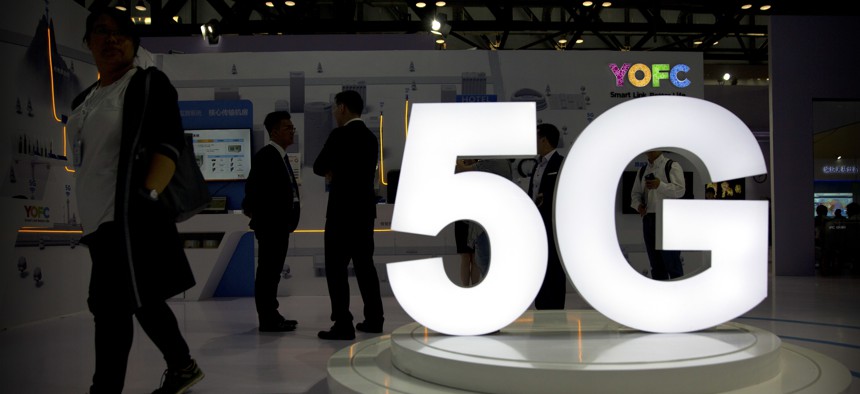Will the FCC’s Small Cell Order Hinder 5G Deployment?

Visitors stand near a 5G logo at a display for Chinese fiber optic cable maker YOFC at the PT Expo in Beijing, Sept. 26, 2018. AP Photo
If cities are to be 5G hubs and close their digital divides, they should be freed up to build out networks, policy experts argued Tuesday.
WASHINGTON — The Federal Communications Commission’s rule preempting local authority over fifth generation wireless partially took effect this week, with policy experts warning Tuesday it would constrain cities’ deployments.
A pair of orders by the 10th U.S. Circuit Court of Appeals last Thursday denied local governments’ requests to stay the rule pending litigation, while approving their requests to transfer their lawsuits back to the Ninth Circuit.
While the rule doesn’t preempt stricter state laws limiting local authority over 5G, it does establish minimum timeframes for processing applications for small cells—radio equipment and antennas inside casing—at 60 days or 90 days, if a new pole is required. If an application is incomplete, the wireless provider must be notified within 10 days barring an agreement to different timeframes.
“I do not believe the FCC was trying to streamline faster deployment … because they really weren't studying that,” said Blair Levin, a lawyer who previously oversaw development of the FCC’s National Broadband Plan, speaking at a Next Century Cities tech policy event in D.C. “They were studying how do we lower costs.”
To that end, the rule requires local application fees be reasonable and cost-based—capping them at $500 for up to five small cells, $100 per additional cell and $1,000 for each involving a new pole.
Law firm Best Best & Krieger has advised its local government clients these are “safe harbor” amounts, only required if their current costs can’t be justified, and the same is true of the rule’s $270 cap on providers’ applications for access to public rights of way.
FCC Commissioner Brendan Carr championed the “common-sense reforms,” arguing they will cut $2 billion in costs stifling deployment of the infrastructure needed for the faster wireless service. Neither Carr nor his Republican colleagues on the FCC responded to a request for comment, possibly due to the federal government shutdown.
“More Americans will see the economic opportunity 5G will enable,” Carr tweeted, after the court’s decision last week. “Needless regulatory roadblocks won’t prevent the build-out of next-gen networks.”
Levin said city officials know more about their localities than providers, and the rule undercuts the effort of cities like San José, California to close their digital divides. That city reached agreements on small cell deployment with Verizon and AT&T that will see thousands of small cells deployed and create a Digital Inclusion Fund for expanding broadband beyond its urban core.
Providers argue savings on urban 5G rollouts will allow them to invest in extending service to more remote, rural areas.
“I work on Wall Street,” Levin said in response to that contention. “That is a special kind of stupid to believe that.”
He pointed to major telecom companies using the $3.5 to $4 billion in additional cash flow some received from Republican-backed tax reform on stock buybacks.
Rather than approve the “one-size-fits-all” rule it did, Levin said, the FCC should have looked into saving up to 40 percent on 5G deployment by encouraging network sharing among the big four providers.
Verizon did not respond to a request for comment, and AT&T referred Route Fifty to its statement when the FCC first approved its rule in September, arguing the new 5G framework “would foster more widespread and robust infrastructure investment.”
Meanwhile, FCC data shows 24.7 million Americans lack access to broadband, mostly centered in rural America. But a Microsoft report from December found that 162.8 million people fail to access the internet at broadband speeds.
At the same Next Century Cities event, FCC Commissioner Jessica Rosenworcel, a Democrat, reiterated the agency’s methodology to figure out and map who has broadband access—and who doesn’t—is a decade old. She said simply asking providers to report service accurately would be a fresh starting point that could be supplemented with the public crowdsourcing where service wanes, data from broadband speed apps and U.S. Postal Service truck drivers who traverse rural roads weighing in.
The U.S. is behind other international economies making mid-band spectrum available, Rosenworcel said. That makes deploying 800,000 small cells by 2026 to make 5G ubiquitous critical, along with fostering more of a relationship between the FCC and state and local partners, she added.
“We are not in Washington interacting with state and local governments when it comes to broadband,” she said.
Part of the FCC rule does not go into effect until April 15, when local aesthetic standards for small cells will be required to be reasonable and no more burdensome than for other infrastructure. Localities must also publish them in advance.
In its advice for local governments, Best Best & Krieger warned there may be another request for a stay in the Ninth Circuit, and the rule eventually could be overturned—advising localities to incorporate it into local law with discretion.
“Everybody talks about the need for 5G leadership; no one defines what that is,” Levin said. “Cities are going to be the leading place where we utilize this stuff.”
Dave Nyczepir is a News Editor at Route Fifty and is based in Washington, D.C.
NEXT STORY: In cloud security, automation does *not* mean automatic






